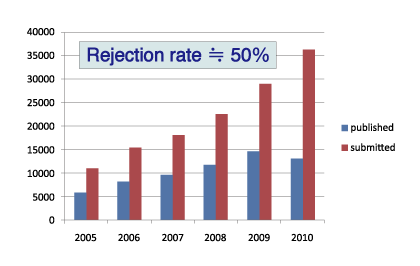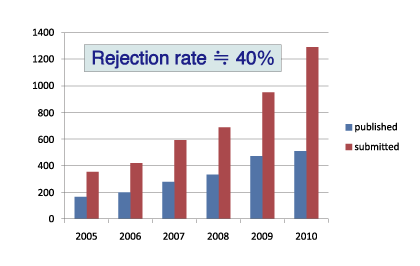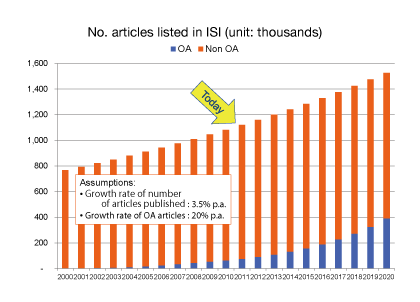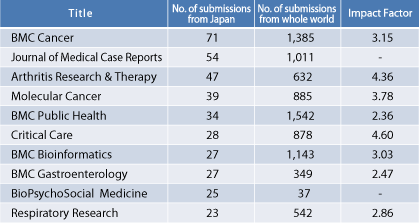Natsu Ishii
(Open Access Manager, Springer Japan KK)
● Introduction
“Open Access” (OA) is most commonly defined as “making original research freely accessible on the web, ideally immediately on publication.”1
This can be achieved in two ways: Green OA and Gold OA. In Green OA, when a paper is accepted for publication, the author makes the manuscript available on a website, such as his or her own site or in the repository of the academic or research institution to which he or she belongs. Gold OA refers to publication of a paper in a peer-reviewed OA journal.
As of September 2011, over 180 academic, research, and funding institutions around the world, including the National Institutes of Health (NIH) in the USA and the Wellcome Trust in the UK, required authors to make their papers available by either Green or Gold OA. Harvard University and Germany’s Max Planck Institute are among the institutions that support the costs of publishing in OA journals for their researchers. These moves toward support for OA have spread rapidly worldwide over the last decade, prompted in part by the problem of soaring journal prices. OA is also well on the way to becoming established as a business model, as demonstrated by the launches of new OA journals announced this year by a number of commercial publishers, among them the Nature Publishing Group2 and Cell Press.3 As yet, however, no Japanese academic, research, or funding institution has a clear policy calling for mandatory OA or financial support for Gold OA, and not many OA journals are published in Japan.
This is the environment in which, in March 2011, Springer launched a serious initiative to develop its OA business in Japan. In this article, speaking as one of the commercial publishers responsible for Gold OA (which I will refer to simply as “OA” hereafter), I will discuss the present situation and plans for the future development of OA business, among other topics.
● The Three Types of OA at Springer
At Springer, we offer three OA programs: (1) “Open Choice,” an OA option, by the article, in established subscription-based journals; (2) BioMed Central (BMC), which publishes OA journals in biomedical fields; and (3) SpringerOpen, which publishes OA journals in fields other than biomedicine.
The first program is a hybrid type, because authors can choose to have their articles published either in the conventional subscription mode or by OA. BMC is a publisher of peer-reviewed OA journals, founded in 2000 and acquired by the Springer Group in 2008; as of November 2011, it was the world’s largest OA publisher, with a lineup of 223 journals. SpringerOpen, launched in 2010, publishes 55 titles (as of November 2011) in fields including mathematics, physics, and computer science. In all three cases, authors whose papers are accepted are required to pay an Article Processing Charge (APC).
BMC retains its independence as a section within the Springer Group and forms the core of our OA business. Thus, the remarks that follow are focused mainly on BMC.
● The State of OA Publishing

Figure 1: Trends in the number of articles submitted to and published by BMC journals (from the whole world)

Figure 2: Trends in the number of articles submitted to and published by BMC journals (from Japan)

Figure 3: Predicted growth rates of total number of articles (non-OA and OA) published and number of Gold OA articles published
Table 1: Top 10 BMC journals in terms of submissions from Japan (2010)

A recent survey found that about 8.5 percent of the scientific articles published in 2008 are accessible by Gold OA.4 Figures 1 and 2 show the trends over the past five years in submissions to BMC’s journals and in actual publication of submitted papers, from the whole world and from Japan. The figures show a steady increase in the number of OA papers, which suggests that these are likely to make up a growing proportion of all scientific papers in future. At Springer, we predict 3.5 percent annual growth in the total number of articles published (OA and non-OA), and about 20 percent annual growth in the number of OA articles (Figure 3). The number of OA journal titles is also on the upswing. According to the Directory of Open Access Journals (DOAJ),5 which compiles information on academic journals for the whole world, as of November 2011 there were over 7,300 OA journal titles. In July 2011 this figure was just over 6,500; thus, the rate of growth is quite striking.
● The Quality of OA Journals
Skeptics often question the quality of OA journals, asking, “Wouldn’t an OA journal that charges the author be prepared to publish any article, as long as they are paid?” The answer to that question is that BMC’s peer reviewing is rigorous; the rejection rate for all its journals averages about 50 percent (Figure 1). Further, BMC is a member of both the Committee on Publication Ethics (COPE)6 and the Open Access Scholarly Publishers Association (OASPA).7 OASPA supports and represents the interests of OA journal and book publishers, and its members include Oxford University Press and the American Physical Society. As the membership criteria are strict, the fact that a journal’s publisher is a member of OASPA can be a quite useful indication of its quality.
The average rejection rate for submissions to BMC journals from Japan is about 40 percent (Figure 2), indicating that articles submitted from Japan are of high quality by international comparison. Table 1 shows the top ten BMC journals in terms of the number of submissions received from Japan in 2010. The total number of submissions to BMC journals that year was slightly more than 35,000. Submissions from Japan were directed to journals with a large number of submissions from the rest of the world and to those with a high Impact Factor.
● The Price of the APC
Another question that often comes up is “Is the APC fair?” Most publishers using the hybrid model mentioned earlier (see “The Three Types of OA at Springer”) have set their APC at about US$3,000. This figure is reportedly based on the costs incurred in publishing an article in both print and electronic formats,1 and can thus be said to be based on the assumption that the existing subscription model will be maintained. BMC, however, is developing its system and its business specifically for OA and online publishing, and it sets the APC based on the costs of providing a better service to authors and editors. As a result, we have achieved a relatively low price compared to others in the field (in 2011 BMC’s standard APC is about US$1,700).
● Who Should Pay the APC?
Who, then, should pay the APC? The candidates generally proposed are scientific and research institutions, libraries, research funders, and the authors themselves. Ideally, perhaps funders should take the lead, but in practice a central role is often played by the libraries of academic and research institutions such as the Max Planck Institute8 in Germany and the University of Calgary9 in Canada.
Japanese authors were asked how they paid the APC in a worldwide survey, the Study of Open Access Publishing (SOAP),10 which in 2009–2011 covered some 40,000 researchers who had published at least one peer-reviewed article in the previous five years. About 45 percent of the Japanese authors who had published in an OA journal replied “The cost of paying the APC was included in my research funds,” while 30 percent answered “My academic or research institution paid.” Surprisingly, 50 percent of Japanese authors—the highest proportion in any country—said it was “easy” to obtain funding for the APC.
Nevertheless, there are likely to be many authors in Japan, too, who have difficulty finding the money for the APC. I would like to see Japanese research funders discuss moving in the direction of OA support, given that most Japanese authors are paying the APC out of their limited research funds, and also in light of the growing number of funding institutions, like the NIH and Wellcome Trust, that have announced a mandatory OA policy. (I should mention that BMC has a system which allows the APC to be waived for authors in low-income nations, mainly in Africa, and others for whom it is financially difficult to pay.)
● Future OA Business Development in Japan
To sum up the state of OA publishing in Japan: submissions to BMC and other OA journals are increasing each year, and the quality of submissions is relatively high. Almost half of all Japanese authors pay the APC out of their research funds, and over half find it easy to obtain the necessary funds. What this tells us is that the OA business market in Japan has the potential for future expansion.
As a commercial publisher involved in OA in this setting, the key to our strategy is promoting OA to authors. We want more authors to be aware of OA’s advantages (better visibility and accessibility), and we want to see still more submissions from Japan to OA journals. Equally important is cooperation with the scientific associations, i.e., fostering the publication of more OA journals in Japan by working together to strengthen Japan’s journal-publishing capacity. This, I suggest, coincides with the mission of SPARC Japan. Since March 2011, we have received a gradually increasing number of queries from associations that want to publish journals with Open Access. In future, we want to engage in discussion and liaison with all parties. Further, as mentioned earlier, we see it as an important duty of ours to approach funding institutions and encourage them to support OA publishing.
● Conclusion
The journal publishing environment has changed dramatically over the last decade. I doubt that anyone could have foreseen ten years ago that an OA-only publisher like BMC would grow to have over 200 journals. Now OA publishing itself is entering a new phase. We see this most clearly in the advent of what are known as “OA mega journals,”13 such as PLoS ONE11 and Nature Communications.12 OA mega journals have an editorial policy of publishing all scientifically sound articles received in any field of research; further, through a cascade system they accept papers rejected by publishers’ flagship journals, such as Plos Biology and Nature‘s sister journals. SpringerPlus, due to be launched by Springer in December 2011,14 will adopt a cascade system for papers rejected by other Springer journals, in addition to direct submissions.
The birth of OA mega journals suggests that the market is in search of new models to accommodate the ever-growing volume of articles accompanying scientific and technological advances. The cascade system actually has many advantages for both reviewers and authors, as it saves not only the time and expense of repeated peer reviews but also labor for authors who until now have had to keep resubmitting an article to different journals, changing the format each time, until it is accepted.
Commercial publishers must not only maintain the quality of their existing journals but also respond to diverse needs and changes in the journal publishing environment with the necessary new services and models. By now, however, it has surely become impossible for any publisher to achieve this alone. We need to form various partnerships, particularly with the university library staff who handle Green OA. As the digitization of journals and books, among other factors, leads to a change in the role of libraries, we can probably expect to see cooperation develop across the boundary between Green and Gold OA. I myself have held a number of discussions with library staff and have been encouraged to find they have an active interest in OA.
It seems to me that close liaison with all the parties concerned, from authors to academic, research, and funding institutions, is the only way forward for commercial publishers.
References
| 1. |
www.stm-assoc.org/2008_04_01_Overview_of_STM_Publishing_Value_to_Research.pdf (accessed 2011-11-22) |
| 2. |
www.nature.com/press_releases/scientificreports.html (accessed 2011-11-17) |
| 3. |
www.eurekalert.org/pub_releases/2011-08/cp-acr080111.php (accessed 2011-11-17) |
| 4. |
Laakso, M; Welling, P; Bukvova, H; Nyman, L; Björk, B-C; Hedlund, T. “The Development of Open Access Journal Publishing from 1993 to 2009.” PLoS ONE. vol. 6, no. 6, 2011, e20961. doi:10.1371/journal.pone.0020961 |
| 5. |
www.doaj.org/ (accessed 2011-11-17) |
| 6. |
http://publicationethics.org/ (accessed 2011-11-17) |
| 7. | www.oaspa.org/ (accessed 2011-11-17) |
| 8. |
www.biomedcentral.com/download/info/MaxPlanckSociety.pdf (accessed 2011-11-17) |
| 9. |
www.biomedcentral.com/download/info/CalgaryCaseStudyFinal.pdf (accessed 2011-11-17) |
| 10. |
http://project-soap.eu/ (accessed 2011-11-17) |
| 11. |
www.plosone.org/home.action (accessed 2011-11-17) |
| 12. |
www.nature.com/ncomms/index.html (accessed 2011-11-17) |
| 13. |
www.slideshare.net/PBinfield/ssp-presentation4 (accessed 2011-11-17) |
| 14. |
www.springerplus.com/ (accessed 2011-11-17) |
|

